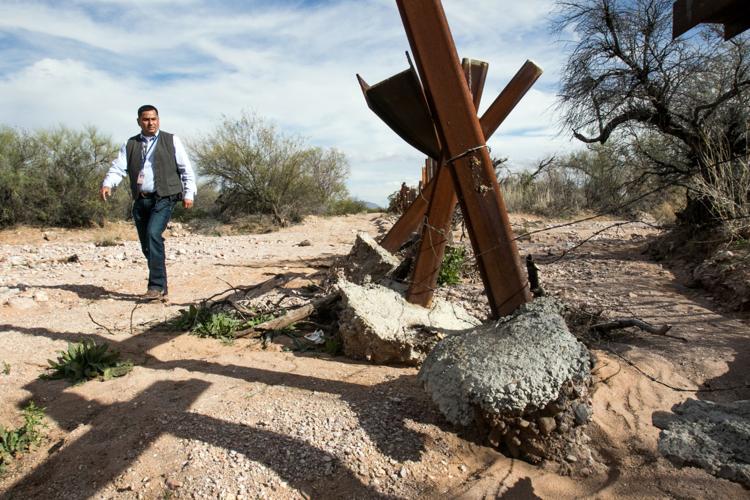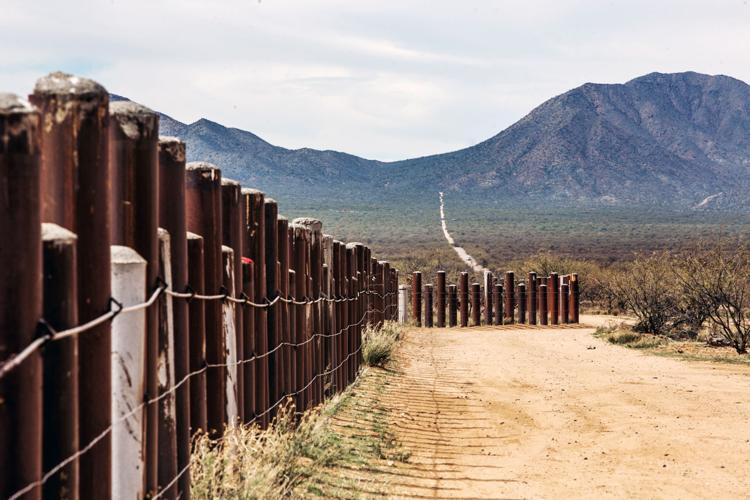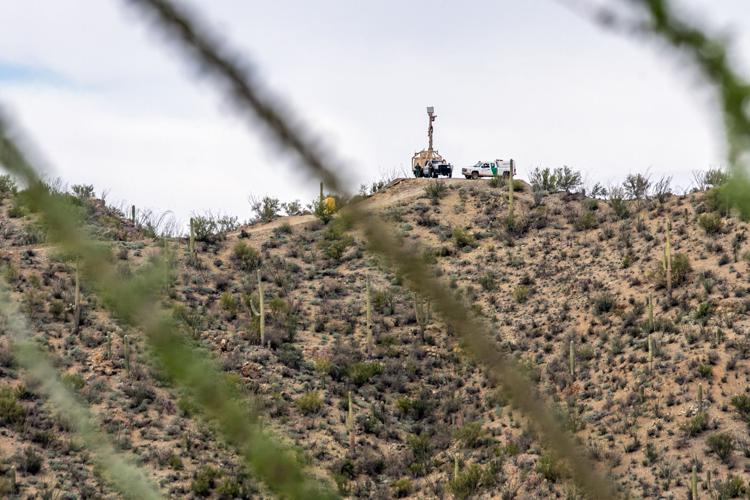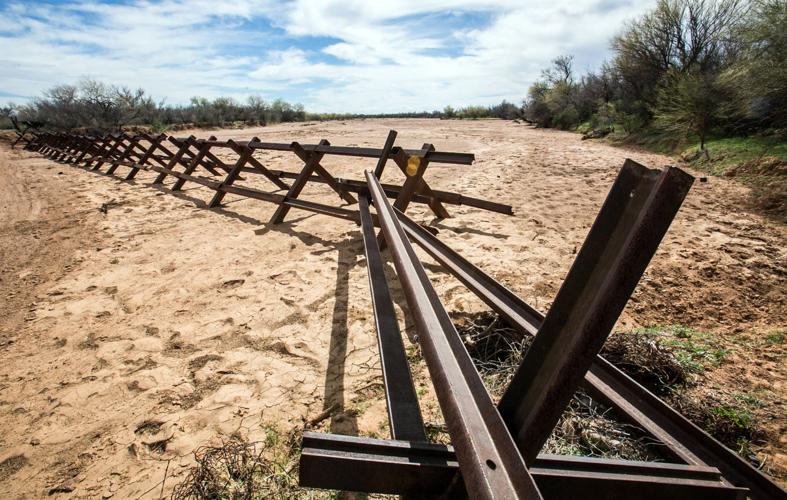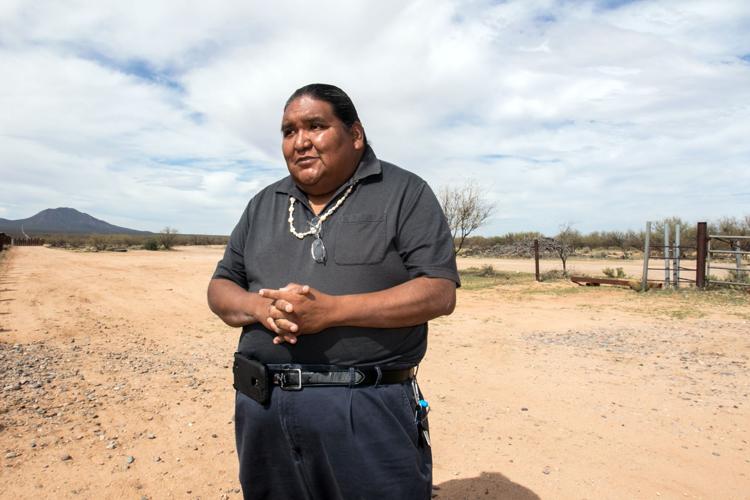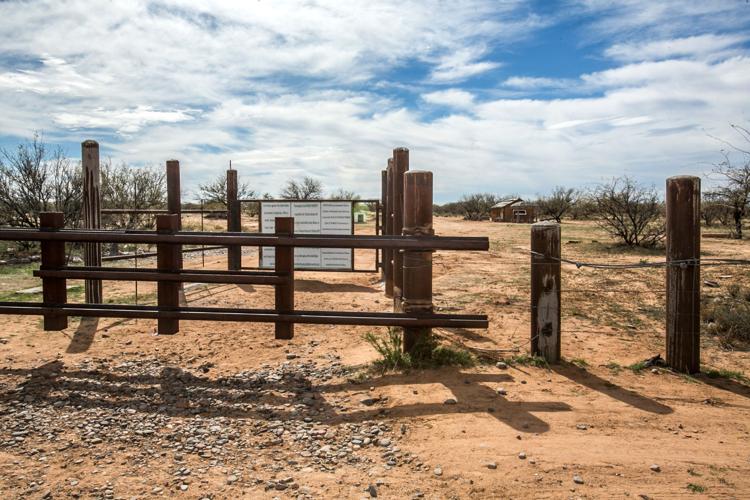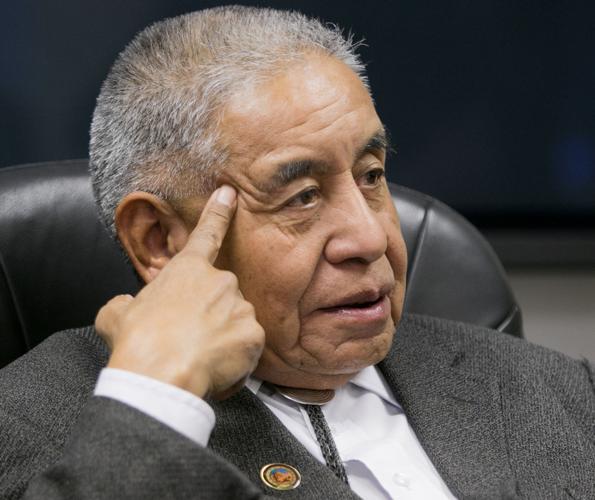TOHONO O’ODHAM RESERVATION — Leaders of the Tohono O’odham Nation southwest of Tucson say they’re confident President Trump’s executive order to build a border wall won’t become a reality on their land.
“The border has already cut our home in half,” said Verlon Jose, vice chairman of the 34,000-member tribe.
Since President Trump’s Jan. 25 executive order to “secure the southern border of the United States through the immediate construction of a physical wall,” the Tohono O’odham Nation has become a focal point of a contentious national issue.
The American Indian nation has been inundated with calls from media around the globe because of its unique situation, as well as from supporters who want to know how they can help.
No other U.S. tribe shares a longer stretch of the international border with Mexico — 75 miles, or 62 miles “as the crow flies,” and tribal officials have long gone on record saying a wall would never be in line with their spiritual connection to the land.
Jose and tribal Chairman Edward Manuel would like President Trump and any other leaders who want to build a physical wall along the southern border to visit the reservation first. If they see it, they’ll understand, tribal officials say.
The tribal leaders traveled to Washington, D.C., last week to meet with Congressional leaders and others to clearly state their position. Manuel said he left feeling positive that the wall won’t happen.
No word for wall
For the Tohono O’odham Nation, the U.S. border with Mexico is an unnatural line that divides their indigenous homelands. About 2,000 of the tribe’s members live in Mexico, and many of them use services such as the dialysis clinic, which is on the U.S. side in Sells. Sells, the tribe’s capital, is about 60 miles southwest of downtown Tucson. The expansive Arizona reservation is roughly the size of Connecticut.
The tribe essentially has a wall already, many members say. Most of the tribe’s border is already lined with steel vehicle barriers that wind around saguaro cacti, across sacred archaeological sites, and allow for rushing waters to cross the border through washes that water their land during summer months.
The added security has had effects. Places where members can legally cross the border with tribal identification cards have shrunk from seven to three in recent years, in some cases tripling travel time to visit families and attend ceremonies in Mexico.
The Serapo family ranch along the tribe’s border with Mexico was literally cut in half by vehicle barriers that went up in 2007 and 2008. Since the family’s well is on the other side of the barrier, they now must travel four miles to get water, Jake Serapo describes in video the tribe has produced about the issue called “There’s No O’odham Word for Wall.”
There is, incidentally, no O’odham word for citizenship, either.
“Whether here or in Mexico, it’s all one land to us,” Manuel said. “It’s just not feasible to put a wall out here on the Tohono O’odham Nation. It’s going to cost too much money, way too much money. More than what they are projecting ... it’s not going to happen.”
”Cost is extreme”
The border is a complicated issue on the reservation, where some members have been frightened by drug runners and related crimes, and want more security.
But tribal leaders officially oppose a physical wall, and that appears to be the prevailing opinion among most members, too.
In the parking lot outside a members-only meeting about the wall on Friday night in Sells, 57-year-old Ronald Felix tended a fire meant to provide a spiritual center for thought and prayer for people leaving the meeting.
“They can leave their emotions here and journey home without burdens and stress,” Felix said, pointing to a pile of creosote for members to burn.
“This issue is very sensitive and contentious. It is hard to put into words. The cost is extreme.”
Amanda Garcia, a 14-year-old tribal member, said everyone she knows opposes a wall. It’s hard enough to visit her family members in Mexico as it is, she said. She is worried about animals not being able to cross the border and is writing a research paper about it for a class at Baboquivari High School.
“Our generation is going to be left with environmental damage in the future,” she said.
Albert Francisco, a 34-year-old student at Tohono O’odham Community College, said he’s afraid of the government’s power. And as a single dad he worries about his daughter’s future.
“We’re not rich out here,” said Francisco. “If we get (Trump) mad, I don’t know if he’ll take things away from us.”
‘Our home’
The executive order on border security calls for a comprehensive study of the southern U.S. border to be completed within 180 days. The study should include the current state of border security, the order says.
Tribal leaders want to make sure the Tohono O’odham Nation has a place at the table for that study, but emphasize that the clock is ticking.
“We are a sovereign nation and they have to talk to us before they make a decision,” Manuel said.
People living near the border should be able to watch the sun set behind a mountain, and not a wall, tribal member Sienna Ventura, 14, wrote Friday in a letter to U.S. Sen. Jeff Flake, an Arizona Republican.
“You are our voice when it comes to the White House, but if they come to us we will be the voice for our tribe,” she wrote. “Our land is our home.”
In an emailed statement to the Star, Flake suggested securing the border might not mean a contiguous wall.
“We need to ensure that we have a secure border using the most effective barriers, which might mean a wall in some places or a fence in others, as well as the right combination of manpower and surveillance,” he wrote. “Arizona communities along the border should be a part of the discussion and planning as they are of the most affected.”
A physical wall on tribal land could also raise constitutional issues in terms of the federal government’s trust responsibilities to the tribe, said Dinah Bear, former chief lawyer for the Council on Environmental Quality under four U.S. presidents and now a Tucson resident.
“But before getting to court, I also think it would generate tremendous pushback from some Congressional members and tribes nationwide,” she said.
Gestures of support
While Manuel and Jose were in D.C., the National Congress of American Indians passed a resolution opposing a continuous physical wall along the southern U.S. border without the consent of affected tribes.
On Feb. 10, the Inter Tribal Association of Arizona, which comprises 21 Arizona tribal governments, passed a similar resolution. Among other things, a continuous wall on the Southern U.S. border would “further divide tribal historic lands and communities,” the association said.
The Tohono O’odham Legislative Council on Feb. 7 passed its own resolution — a five-page document that among other things says the reservation is “not public land.” Rather, “it is reserved for the benefit of the nation and its members, and the nation has a duty to ensure that tribal members’ rights and the nation’s sovereignty are protected,” the resolution says.
The tribe wants the public to understand that it has already worked hard to create a secure border by working with U.S. Customs and Border Protection, which is part of the Department of Homeland Security. The reservation has two law enforcement centers in border areas that have historically had high levels of illegal activity.
Both the Tohono O’odham Police Department and the U.S. Border Patrol work out of the centers in a cooperative partnership that is unique along the border, said Richard Saunders, executive director of the Tohono O’odham Nation’s Department of Public Safety.
Saunders began his career as a Tohono O’odham police officer in 1987, back when the border was demarcated by a three-strand barbed wire fence. Members at one time traveled freely between the two countries.
But as security tightened at ports of entry during the 1990s, illegal activity was increasingly pushed into more remote areas like the Tohono O’odham reservation.
Then 9/11 happened, and that was followed by the 2006 Secure Fence Act, which added the waist-high vehicle barriers to most of the reservation’s border. And the number of federal personnel on the border increased significantly, Saunders said.
After the vehicle barriers went up, apprehensions along the border dropped — an 84 percent decline in the last decade. Still, the tribe spends $3 million per year on border-related issues, including police time, autopsies of migrants, and hospital costs for migrants who need medical care, tribal officials say.
Last year there were 85 death investigations of migrants who were found on the reservation, Saunders said.
Now, a plan for 15 surveillance towers within the Chukut Kuk and Gu-Vo border districts is underway. Some tribal members are opposing those, saying the Border Patrol’s presence on the reservation has already hurt vegetation and animal habitat, and that the towers will only make it worse.
Nature disrupted
The sign that welcomes visitors to the reservation has an O’odham phrase, “Sic Has Elid g Jewed,” which means “Respect the Land.” Every stick and stone is sacred, every creature is sacred and has a significant part in the O’odham way of life, Jose said.
One of the biggest worries for the tribe is how it will harm the Earth, Jose said Friday as he drove along a bumpy road beside the tribe’s border with Mexico.
“The rattlesnakes don’t know what season it is, the saguaros aren’t blooming on schedule,” he said. “It is what humans are doing to Mother Earth. In order for the world to be in balance, Mother Nature has to be in balance, too.”
The remote tribal borderlands are dramatic, with jungles of mesquite trees, vast, thick stands of saguaros, mountains and sheer cliffs. It is this rugged desert of the tribe’s borderlands that makes a solid wall unworkable in many locations, he said.
Jose last summer got attention for saying the border wall would be constructed “over my dead body.” He hasn’t backed down from that statement, but stressed he doesn’t want to be dead.
He’d rather work together — to hold hands with the rest of the U.S. to solve the problem, he said.
“If we didn’t care so much about the land, about our people, we wouldn’t be raising a fuss,” Jose said.


